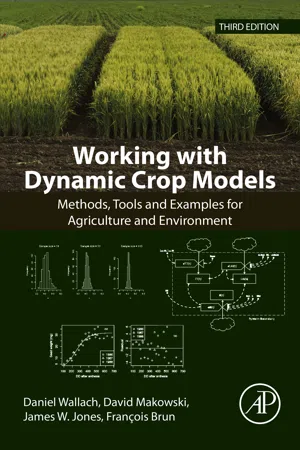
Working with Dynamic Crop Models
Methods, Tools and Examples for Agriculture and Environment
Daniel Wallach,David Makowski,James W. Jones,Francois Brun
- 613 pagine
- English
- ePUB (disponibile sull'app)
- Disponibile su iOS e Android
Working with Dynamic Crop Models
Methods, Tools and Examples for Agriculture and Environment
Daniel Wallach,David Makowski,James W. Jones,Francois Brun
Informazioni sul libro
Working with Dynamic Crop Models: Methods, Tools and Examples for Agriculture and Environment, 3e, is a complete guide to working with dynamic system models, with emphasis on models in agronomy and environmental science. The introductory section presents the foundational information for the book including the basics of system models, simulation, the R programming language, and the statistical notions necessary for working with system models. The most important methods of working with dynamic system models, namely uncertainty and sensitivity analysis, model calibration (frequentist and Bayesian), model evaluation, and data assimilation are all treated in detail, in individual chapters.
New chapters cover the use of multi-model ensembles, the creation of metamodels that emulate the more complex dynamic system models, the combination of genetic and environmental information in gene-based crop models, and the use of dynamic system models to aid in sampling.
The book emphasizes both understanding and practical implementation of the methods that are covered. Each chapter simply and clearly explains the underlying principles and assumptions of each method that is presented, with numerous examples and illustrations. R code for applying the methods is given throughout. This code is designed so that it can be adapted relatively easily to new problems.
- An expanded introductory section presents the basics of dynamic system modeling, with numerous examples from multiple fields, plus chapters on numerical simulation, statistics for modelers, and the R language
- Covers in detail the basic methods: uncertainty and sensitivity analysis, model calibration (both frequentist and Bayesian), model evaluation, and data assimilation
- Every method chapter has numerous examples of applications based on real problems, as well as detailed instructions for applying the methods to new problems using R
- Each chapter has multiple exercises for self-testing or for classroom use
- An R package with much of the code from the book can be freely downloaded from the CRAN package repository
Domande frequenti
Informazioni
The Models Included in the ZeBook R Package: Description, R Code, and Examples of Results
1 Introduction
| Short Name | Description | Field | R Function in the ZeBook Package |
|---|---|---|---|
| SeedWeight | Grain filling for wheat (from Darroch and Baker, 1990) | Agronomy | seedweight.model |
| Magarey | Generic model of infection for foliar diseases caused by fungi (from Magarey et al., 2005) | Plant protection | magarey.model |
| CarbonSoil | Model of soil carbon content, annual time step (adapted from Hénin-Dupuis model, Jones et al., 2004) | Agronomy environment | carbonsoil.model |
| WaterBalance | Budget-based soil water balance model for grass (from Woli, 2010) | Agronomy | watbal.model |
| Maize | Model of crop growth for maize cultivated in potential conditions (based on widely used concepts for crop modeling) | Agronomy | maize.model |
| Verhulst | Homogenous population with limited food supply | Ecology | verhulst.model |
| PopulationAge | Population dynamics model with age classes | Ecology | population.age.model population.age.matrix.model population.age.model.ode |
| PredatorPrey | Predator-prey population dynamics model | Ecology | predator.prey.model |
| Weed | Model of wheat yield under conditions of a weed infestation of blackgrass (from Munier-Jolain et al., 2002) | Agronomy Plant protection | weed.model |
| Epirice | Disease model for rice (from Savary et al., 2012) | Plant protection | epirice.model |
| Cotton | Model of dynamic for numbers of cotton fruiting points (Wallach... |
Indice dei contenuti
- Cover image
- Title page
- Table of Contents
- Copyright
- Preface
- Acknowledgments
- Section A: Background
- Section B: Basic Methods
- Section C: Advanced Methods
- Appendix 1: The Models Included in the ZeBook R Package: Description, R Code, and Examples of Results
- Appendix 2: An Overview of the R Package ZeBook
- Index